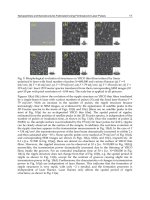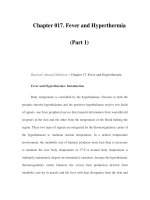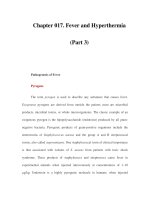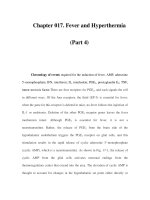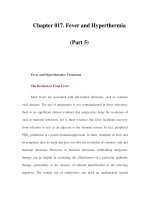Chapter 018. Fever and Rash (Part 2) pot
Bạn đang xem bản rút gọn của tài liệu. Xem và tải ngay bản đầy đủ của tài liệu tại đây (16.19 KB, 5 trang )
Chapter 018. Fever and Rash
(Part 2)
Centrally Distributed Maculopapular Eruptions
Centrally distributed rashes, in which lesions are primarily truncal, are the
most common type of eruption. The rash of rubeola (measles) starts at the hairline
2–3 days into the illness and moves down the body, sparing the palms and soles
(Chap. 185). It begins as discrete erythematous lesions, which become confluent
as the rash spreads. Koplik's spots (1- to 2-mm white or bluish lesions with an
erythematous halo on the buccal mucosa) are pathognomonic for measles and are
generally seen during the first 2 days of symptoms. They should not be confused
with Fordyce's spots (ectopic sebaceous glands), which have no erythematous
halos and are found in the mouth of healthy individuals. Koplik's spots may briefly
overlap with the measles exanthem.
Rubella (German measles) also spreads from the hairline downward; unlike
that of measles, however, the rash of rubella tends to clear from originally affected
areas as it migrates, and it may be pruritic (Chap. 186). Forchheimer spots (palatal
petechiae) may develop but are nonspecific since they also develop in
mononucleosis (Chap. 174) and scarlet fever (Chap. 130). Postauricular and
suboccipital adenopathy and arthritis are common among adults with German
measles. Exposure of pregnant women to ill individuals should be avoided, as
rubella causes severe congenital abnormalities. Numerous strains of enteroviruses
(Chap. 184), primarily echoviruses and coxsackieviruses, cause nonspecific
syndromes of fever and eruptions that may mimic rubella or measles. Patients with
infectious mononucleosis caused by Epstein-Barr virus (Chap. 174) or with
primary infection caused by HIV (Chap. 182) may exhibit pharyngitis,
lymphadenopathy, and a nonspecific maculopapular exanthem.
The rash of erythema infectiosum (fifth disease), which is caused by human
parvovirus B19, primarily affects children 3–12 years old; it develops after fever
has resolved as a bright blanchable erythema on the cheeks ("slapped cheeks")
with perioral pallor (Chap. 177). A more diffuse rash (often pruritic) appears the
next day on the trunk and extremities and then rapidly develops into a lacy
reticular eruption that may wax and wane (especially with temperature change)
over 3 weeks. Adults with fifth disease often have arthritis, and fetal hydrops can
develop in association with this condition in pregnant women.
Exanthem subitum (roseola) is caused by human herpesvirus 6 and is most
common among children <3 years of age (Chap. 175). As in erythema
infectiosum, the rash usually appears after fever has subsided. It consists of 2- to
3-mm rose-pink macules and papules that rarely coalesce, occur initially on the
trunk and sometimes on the extremities (sparing the face), and fade within 2 days.
Although drug reactions have many manifestations, including urticaria,
exanthematous drug-induced eruptions (Chap. 56) are most common and are often
difficult to distinguish from viral exanthems. Eruptions elicited by drugs are
usually more intensely erythematous and pruritic than viral exanthems, but this
distinction is not reliable. A history of new medications and an absence of
prostration may help to distinguish a drug-related rash from an eruption of another
etiology. Rashes may persist for up to 2 weeks after administration of the
offending agent is discontinued. Certain populations are more prone than others to
drug rashes. Of HIV-infected patients, 50–60% develop a rash in response to sulfa
drugs; 90% of patients with mononucleosis due to Epstein-Barr virus develop a
rash when given ampicillin.
Rickettsial illnesses (Chap. 167) should be considered in the evaluation of
individuals with centrally distributed maculopapular eruptions. The usual setting
for epidemic typhus is a site of war or natural disaster in which people are exposed
to body lice. A diagnosis of recrudescent typhus should be considered in European
immigrants to the United States. However, an indigenous form of typhus,
presumably transmitted by flying squirrels, has been reported in the southeastern
United States. Endemic typhus or leptospirosis (the latter caused by a spirochete;
Chap. 164) may be seen in urban environments where rodents proliferate. Outside
the United States, other rickettsial diseases cause a spotted-fever syndrome and
should be considered in residents of or travelers to endemic areas. Similarly,
typhoid fever, a nonrickettsial disease caused by Salmonella typhi (Chap. 146), is
usually acquired during travel outside the United States. Dengue fever, caused by
a mosquito-transmitted flavivirus, occurs in tropical and subtropical regions of the
world (Chap. 189).
Some centrally distributed maculopapular eruptions have distinctive
features. Erythema chronicum migrans (ECM), the rash of Lyme disease (Chap.
166), typically manifests as singular or multiple annular plaques. Untreated ECM
lesions usually fade within a month but may persist for more than a year.
Erythema marginatum, the rash of acute rheumatic fever (Chap. 315), has a
distinctive pattern of enlarging and shifting transient annular lesions.
Collagen vascular diseases may cause fever and rash. Patients with systemic
lupus erythematosus (Chap. 313) typically develop a sharply defined,
erythematous eruption in a butterfly distribution on the cheeks (malar rash) as well
as many other skin manifestations. Still's disease (Chap. 331) manifests as an
evanescent salmon-colored rash on the trunk and proximal extremities that
coincides with fever spikes.
Peripheral Eruptions
These rashes are alike in that they are most prominent peripherally or begin
in peripheral (acral) areas before spreading centripetally. Early diagnosis and
therapy are critical in RMSF (Chap. 167) because of its grave prognosis if
untreated. Lesions evolve from macular to petechial, start on the wrists and ankles,
spread centripetally, and appear on the palms and soles only later in the disease.
The rash of secondary syphilis (Chap. 162), which may be generalized but is
prominent on the palms and soles, should be considered in the differential
diagnosis of pityriasis rosea, especially in sexually active patients. Atypical
measles (Chap. 185) is seen in individuals contracting measles who received the
killed measles vaccine between 1963 and 1967 in the United States and who were
not subsequently protected with the live vaccine. Hand-foot-and-mouth disease
(Chap. 184), most commonly caused by coxsackievirus A16, is distinguished by
tender vesicles distributed peripherally and in the mouth; outbreaks commonly
occur within families. The classic target lesions of erythema multiforme (EM)
appear symmetrically on the elbows, knees, palms, soles, and face. In severe cases,
these lesions spread diffusely and involve mucosal surfaces. Stevens-Johnson
syndrome is considered a maximal form of erythema multiforme and is life-
threatening. Lesions may develop on the hands and feet in endocarditis (Chap.
118).
